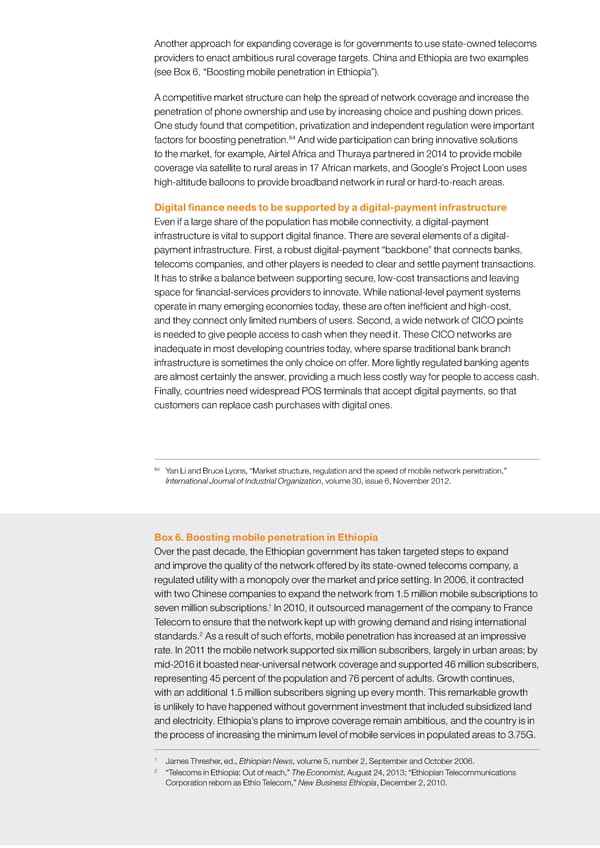Another approach for expanding coverage is for governments to use state-owned telecoms providers to enact ambitious rural coverage targets. China and Ethiopia are two examples (see Box 6, “Boosting mobile penetration in Ethiopia”). A competitive market structure can help the spread of network coverage and increase the penetration of phone ownership and use by increasing choice and pushing down prices. One study found that competition, privatization and independent regulation were important 84 factors for boosting penetration. And wide participation can bring innovative solutions to the market, for example, Airtel Africa and Thuraya partnered in 2014 to provide mobile coverage via satellite to rural areas in 17 African markets, and Google’s Project Loon uses high-altitude balloons to provide broadband network in rural or hard-to-reach areas. Digital finance needs to be supported by a digital-payment infrastructure Even if a large share of the population has mobile connectivity, a digital-payment infrastructure is vital to support digital finance. There are several elements of a digital- payment infrastructure. First, a robust digital-payment “backbone” that connects banks, telecoms companies, and other players is needed to clear and settle payment transactions. It has to strike a balance between supporting secure, low-cost transactions and leaving space for financial-services providers to innovate. While national-level payment systems operate in many emerging economies today, these are often inefficient and high-cost, and they connect only limited numbers of users. Second, a wide network of CICO points is needed to give people access to cash when they need it. These CICO networks are inadequate in most developing countries today, where sparse traditional bank branch infrastructure is sometimes the only choice on offer. More lightly regulated banking agents are almost certainly the answer, providing a much less costly way for people to access cash. Finally, countries need widespread POS terminals that accept digital payments, so that customers can replace cash purchases with digital ones. 84 Yan Li and Bruce Lyons, “Market structure, regulation and the speed of mobile network penetration,” International Journal of Industrial Organization, volume 30, issue 6, November 2012. Box 6. Boosting mobile penetration in Ethiopia Over the past decade, the Ethiopian government has taken targeted steps to expand and improve the quality of the network offered by its state-owned telecoms company, a regulated utility with a monopoly over the market and price setting. In 2006, it contracted with two Chinese companies to expand the network from 1.5 million mobile subscriptions to 1 In 2010, it outsourced management of the company to France seven million subscriptions. Telecom to ensure that the network kept up with growing demand and rising international 2 standards. As a result of such efforts, mobile penetration has increased at an impressive rate. In 2011 the mobile network supported six million subscribers, largely in urban areas; by mid-2016 it boasted near-universal network coverage and supported 46 million subscribers, representing 45 percent of the population and 76 percent of adults. Growth continues, with an additional 1.5 million subscribers signing up every month. This remarkable growth is unlikely to have happened without government investment that included subsidized land and electricity. Ethiopia’s plans to improve coverage remain ambitious, and the country is in the process of increasing the minimum level of mobile services in populated areas to 3.75G. 1 James Thresher, ed., Ethiopian News, volume 5, number 2, September and October 2006. 2 “Telecoms in Ethiopia: Out of reach,” The Economist, August 24, 2013; “Ethiopian Telecommunications Corporation reborn as Ethio Telecom,” New Business Ethiopia, December 2, 2010. 62 McKinsey Global Institute 4. Capturing the opportunity
 DIGITAL FINANCE FOR ALL Page 76 Page 78
DIGITAL FINANCE FOR ALL Page 76 Page 78